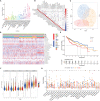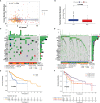The Heterogeneity of Immune Cell Infiltration Landscape and Its Immunotherapeutic Implications in Hepatocellular Carcinoma
- PMID: 35355983
- PMCID: PMC8959995
- DOI: 10.3389/fimmu.2022.861525
The Heterogeneity of Immune Cell Infiltration Landscape and Its Immunotherapeutic Implications in Hepatocellular Carcinoma
Abstract
Immunotherapy, closely associated with immune infiltration and tumor mutation burden (TMB), is emerging as a promising strategy for treating tumors, but its low response rate in hepatocellular carcinoma (HCC) remains a major challenge. Herein, we applied two algorithms to uncover the immune infiltration landscape of the immune microenvironment in 491 HCC patients. Three immune infiltration patterns were defined using the CIBERSORT method, and the immune cell infiltration (ICI) scores were established using principal component analysis. In the high ICI score group, the activation of the Wnt/β-catenin pathway was significantly enriched and expressions of immune checkpoint genes increased, which showed a pessimistic outcome. The low ICI score group was characterized by increased TMB and enrichment of metabolism-related pathways. Further analysis found that the ICI score exhibited a significant difference in age ≥65/age <65, grade I/grade II-IV, and response to immunotherapy. Moreover, the CTNNB1 mutation status was found to be closely associated with prognosis and immunotherapeutic efficiency, significantly affecting the ICI score and TMB, which might be regarded as a potential marker for the treatment of HCC. The evaluation of immune infiltration patterns can improve the understanding of the tumor immune microenvironment and provide new directions for the study of individualized immunotherapy strategies for HCC.
Keywords: hepatocellular carcinoma; immune cell infiltration; immune microenvironment; tumor heterogeneity; tumor mutational burden.
Copyright © 2022 Guo, Yang, Ren, Tian, Gao, Tian, Zhang and Kan.
Conflict of interest statement
The authors declare that the research was conducted in the absence of any commercial or financial relationships that could be construed as a potential conflict of interest.
Figures







Similar articles
-
Exploration of Key Genes Combining with Immune Infiltration Level andTumor Mutational Burden in Hepatocellular Carcinoma.Comb Chem High Throughput Screen. 2024;27(14):2110-2124. doi: 10.2174/0113862073239916231023053142. Comb Chem High Throughput Screen. 2024. PMID: 38213141
-
Identification of the immune cell infiltration landscape in pancreatic cancer to assist immunotherapy.Future Oncol. 2021 Nov;17(31):4131-4143. doi: 10.2217/fon-2021-0495. Epub 2021 Aug 4. Future Oncol. 2021. PMID: 34346253
-
Landscape of Immune Microenvironment Under Immune Cell Infiltration Pattern in Breast Cancer.Front Immunol. 2021 Aug 27;12:711433. doi: 10.3389/fimmu.2021.711433. eCollection 2021. Front Immunol. 2021. PMID: 34512634 Free PMC article.
-
Long non-coding rnas as key modulators of the immune microenvironment in hepatocellular carcinoma: implications for Immunotherapy.Front Immunol. 2025 Apr 25;16:1523190. doi: 10.3389/fimmu.2025.1523190. eCollection 2025. Front Immunol. 2025. PMID: 40352941 Free PMC article. Review.
-
Immune microenvironment infiltration landscape and immune-related subtypes in prostate cancer.Front Immunol. 2023 Jan 9;13:1001297. doi: 10.3389/fimmu.2022.1001297. eCollection 2022. Front Immunol. 2023. PMID: 36700224 Free PMC article. Review.
Cited by
-
Ficolin-2: A potential immune-related therapeutic target with low expression in liver cancer.Front Oncol. 2022 Nov 8;12:987481. doi: 10.3389/fonc.2022.987481. eCollection 2022. Front Oncol. 2022. PMID: 36425563 Free PMC article.
-
High LGALS3 expression induced by HCP5/hsa-miR-27b-3p correlates with poor prognosis and tumor immune infiltration in hepatocellular carcinoma.Cancer Cell Int. 2024 Apr 20;24(1):142. doi: 10.1186/s12935-024-03309-1. Cancer Cell Int. 2024. PMID: 38643145 Free PMC article.
-
Study of TRAF3IP3 for prognosis and immune infiltration in hepatocellular carcinoma.PeerJ. 2024 Dec 12;12:e18538. doi: 10.7717/peerj.18538. eCollection 2024. PeerJ. 2024. PMID: 39677949 Free PMC article.
-
Single-Gene Mutations in Hepatocellular Carcinoma: Applications and Challenges in Precision Medicine.Int J Med Sci. 2025 Jul 10;22(13):3268-3276. doi: 10.7150/ijms.117603. eCollection 2025. Int J Med Sci. 2025. PMID: 40765562 Free PMC article. Review.
-
The current understanding of the immune landscape relative to radiotherapy across tumor types.Front Immunol. 2023 Mar 16;14:1148692. doi: 10.3389/fimmu.2023.1148692. eCollection 2023. Front Immunol. 2023. PMID: 37006319 Free PMC article. Review.
References
-
- Osipov A, Lim SJ, Popovic A, Azad NS, Laheru DA, Zheng L, et al. . Tumor Mutational Burden, Toxicity, and Response of Immune Checkpoint Inhibitors Targeting PD(L)1, CTLA-4, and Combination: A Meta-Regression Analysis. Clin Cancer Res (2020) 26:4842–51. doi: 10.1158/1078-0432.CCR-20-0458 - DOI - PMC - PubMed
Publication types
MeSH terms
Substances
LinkOut - more resources
Full Text Sources
Medical
Miscellaneous

